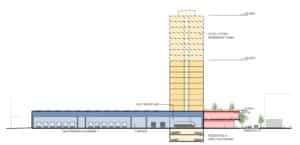
A conceptual design for a commercial real estate development on top of a redeveloped Albany Street MBTA bus garage in Boston's South End. Image courtesy of A Better City and Jacobs Engineering Group Inc.
If the MBTA wants to expand or electrify its bus fleet, which carries one in three of its riders and on which many have pinned their hopes for congestion-defeating transit improvements, it needs to come up with around $1 billion or more. Commercial real estate development could provide that cash, a new report suggests.
All of the bus maintenance garages are already at or above capacity – the Albany Street garage in Boston tends to 116 vehicles despite being designed to handle 35 – and they will need significant redesigns or replacements to be able to handle electric buses, MBTA Chief Engineer Erik Stoothoff said during a Wednesday panel discussion organized by business group A Better City.
The goal, he said, is to make improvements to facilities now so that switching over to electric buses can be a “one-to-one swap” years away.
“Electric or otherwise, the maintenance facilities need investment,” Stoothoff told reporters after the event. “We’re planning on what that investment is going to look like that can support the fleet we have today and the evolution of that fleet from diesel to hybrid to battery electric.”
The MBTA last week introduced the first of five battery electric buses that will run on the Silver Line as part of a pilot program, and there are also plans in place to add another 194 hybrid buses on top of the more than 200 already in service.
One option to balance those needs, suggested by the A Better City organization that convened experts and officials for Wednesday’s event, would be to pursue mixed-use developments for future MBTA service garages.
In a report released alongside the panel discussion, ABC researchers used the Albany Street garage as a case study to conclude that combining an electric-equipped maintenance facility with residential or retail properties could help accelerate necessary investment. That could be key, said co-author Glen Berkowitz, because of the high price tag over the next decade to improve bus facilities to allow for electrification.
“There’s about $1 billion plus that we as a society here in the Boston metro region have to find in the next 13 years to rebuild or replace all of our bus maintenance facilities,” Berkowitz said. “It’s largely unfunded.”
Other transit activists have suggested the T could get better use from its bus maintenance facilities if most are moved towards the system’s periphery.
The MBTA has several bus facilities in neighborhoods that have seen substantial commercial real estate development in this cycle.






